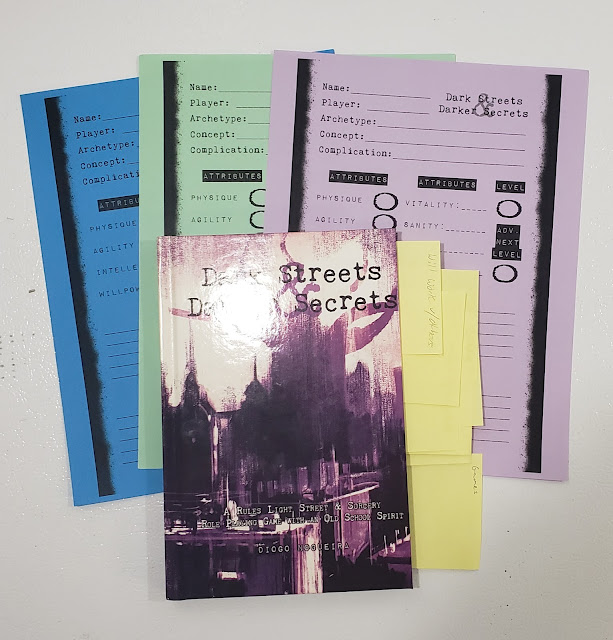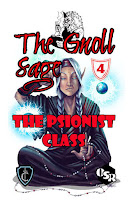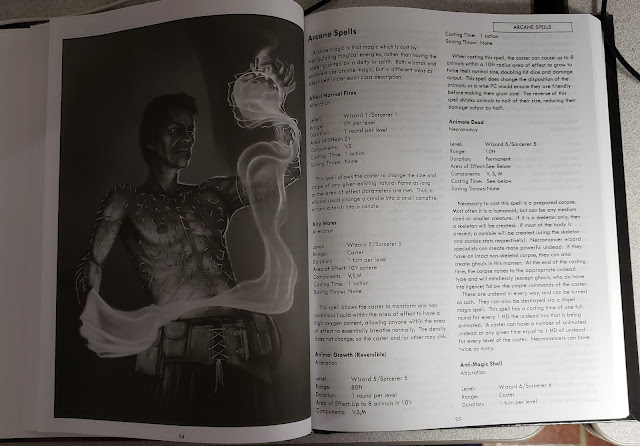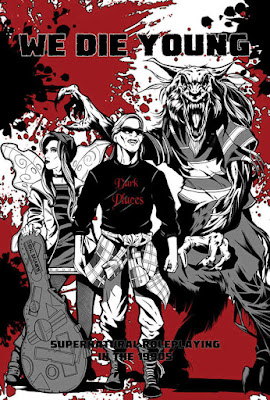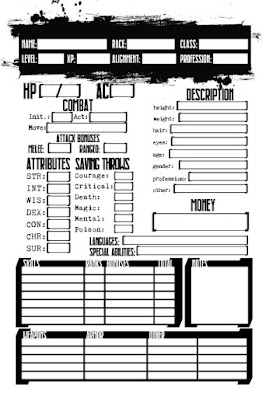A couple of things though to get started. Dark Streets & Darker Secrets (DS&DS) is a modern occult horror game based on old-school style mechanics. I also have a modern occult horror game based on old-school style mechanics. So I am aware that any criticism I might lay on this game could come off as sounding self-serving. I want to always be aware of this and have you the reader keep this in mind as you read my review here. Also the author, Diogo Nogueira, also lists the Buffy the Vampire Slayer RPG from Eden as one of his inspirations. This game was also Jason Vey's and my inspiration for NIGHT SHIFT. Jason and I met while working on Buffy. NIGHT SHIFT was designed to fit "the Buffy shaped hole" in our lives as I have said before. So both games come from very, very similar backgrounds with very, very similar goals. That all being said, DS&DS is NOT in competition with NIGHT SHIFT. Nor is Diogo a competitor. I consider him a colleague. Both Dark Streets & Darker Secrets and NIGHT SHIFT can, and do, live on my shelves and game table in complete peace with each other. I am going to spend some time tomorrow talking about how both games (and two more) can be used together. Today though I am going to talk about where DS&DS shines (is that the proper word for a "dark" game?) and what it does.
So let's get to it.
by Diogo Nogueira. 222 pages, hardcover. Color cover with black and white interior art. For this review, I am considering both the PDF and the Print on Demand hardcovers from DriveThruRPG.
Dark Streets & Darker Secrets (DS&DS) is a modern occult horror game from ENnie Award winner Diogo Nogueira. The book is digest size so it fit well with many "old school" style books of the last 10 years. It not only fits on the shelf physically but thematically as well. The game is based on Nogueira's earlier works Sharp Swords & Sinister Spells and Solar Blades & Cosmic Spells, so out of the gate there are more resources for this game if you desire.
The game itself is a gritty, modern occult/supernatural horror game. The normal humans are just slightly above average for the most part and the monsters are way more powerful. Immediately I thought of it as a bit of Chill mixed in with Kult. The feel is very much "humanity alone against the darkness."
The book is laid out in eight chapters with some appendices.
Chapter 1: Introduction
This chapter covers the basics of what is in the book.
Chapter 2: Character Creation
If you have played any old-school-like game in the last 45+ years you have an idea what this chapter is about. The differences here fit the tone of the game. Character attributes are rolled using a 2d6+3 (not a 3d6 or even 4d6 drop the lowest), this creates a narrower band of character attributes, 5-15 but still on the same human range of 3-18. There is a chance to increase these later on. The attribute themselves are a simplified version of the Basic 6; Physique (combining Strength and Constitution), Agility (Dexterity), Intellect (Intelligence), and Willpower (Wisdom and Charisma). Once those are done you create a character concept which is a basic couple word description and not a backstory.
After this, it is time to choose the Archetype or essentially the class of the character. They are The Tough, The Nimble, The Smart, and The Gifted. These align with the attributes above. The Gifted is special in that you can be a spell-caster or even a supernatural creature like a vampire, werewolf, or even an alien. Each archetype also gets a "recovery roll" which decides how quick they can bounce back from injury.
Since this is a gritty sort of universe all characters have a complication. These can come into play in the game to keep things "difficult and exciting" for the characters. It includes a d66 table (roll 2d6 and use the rolls like d%. Traveller people know this one well).
Then you pick out some gear. If it is mundane gear you have it. You also get some weapons and "weird" gear. These are detailed in the next chapter.
Finally, we have derived scores. Vitality (Physique + Level) are your "hit points." Sanity, or mental stability, is equal to your Intellect. Now I have mentioned before I do not like how many games handle insanity or madness. Sadly this game is not an exception. I spent a few years working in a mental health facility back when I was in grad school. There is no relationship between intelligence and mental health. In fact, I had one guy who was schizophrenic and could speak 3 or 4 languages including German and Swahili. He learned I also spoke German and would use that when he wanted to talk about the other clients "in secret" to me. So yeah. I am not really a fan of this one. I'd rather roll a 2d6 and then add a bonus from Willpower (and maybe Intellect) to get my Sanity score. There is also Luck points which are like fate points or drama points (everyone starts with 3) and Money.
Chapter 3: Gear
Covers mundane gear, expendable gear (like ammunition and things that wear out) and even some weird gear. Weird items are the best part. Every character has one weird item they start off with. This is easily explainable either they found it and thus introduced to the weirder world OR they have always had it and the world is waiting for them. There is a d100 table that covers a bunch of different sorts of items. Note, we just get the names of the items, what they do will be discovered in-game.
Additionally, drugs, services, illegal goods, and money points (abstraction of money carried) are also dealt with.
Chapter 4: Rules of the City
Here are our basic rules for the game. Everything is an attribute check (roll under your attribute modified by level and difficulty). There are some neat quirks. There is an advantage/disadvantage system here called Positive and Negative rolls. Rolling on your attribute is considered a critical success. You roll lower than your attribute to succeed, BUT higher than the difficulty. So if something has a difficulty of 8 and my attribute is 12 I have to roll a 12 or lower BUT also higher than an 8. So only rolls of 9, 10, 11, and 12 will get me a success.
Players can add a Luck roll to their challenges. This is not a matter of just adding points. You have to roll a d6. If it is equal to or lower than their luck score then you get to make a situation more favorable.
This chapter also covers sanity and madness. You lose Sanity if you encounter something strange and fail a Willpower test. Difficulty set by the situation. Points lost also can vary. When the character's Sanit score reaches 0 then they get a Madness. Thankfully there is no list of "madnesses" here. Most game designers get these horribly wrong anyways. In game you get a minor "quirk" on your first loss. If you suffer 4 losses then the character has succumbed to madness and can't be played.
Level advancement is a form of Milestone advancement that looks like it should work rather well. Again individual GMs can (and should) alter this to fit their needs.
Chapter 5: Combat
Like many RPGs combat gets a special chapter even if it is just a particular form of the rules stated above. But if one is going to fight the armies of darkness then one is expected to actually fight. Reading through this you get the idea that yes the characters can be tough. You also get the idea that the things they are fighting are a lot tougher. While there are a few ways the players can save their character's bacon, there are still a lot of grisly ways to die in this game.
Chapter 6: Sorcery and Psychic Powers
Ah, now this is the meat of the game in my mind. A Gifted character can be a sorcerer, a witch, a psychic or some other type of creature. Their powers and how to use them are detailed here. Regardless of the origin or the nature of the powers, game-wise they are treated in similar manners, the difference largely being different Backlash tables. How they are played can vary wildly. I mentioned that this is grittier game than one would see in say a Buffy-like game. The previously mentioned Backlash is one and Corruption is another. These include simple things like a "witch's mark" to changes to one's body and mind or just getting pulled right into the Abyss. Pro-tip, don't botch your rolls.
A very nice (and long) list of powers is given with their effects. While the list is long (60 entries) it is not exhaustive.
Additionally, Arcane artifacts are covered. How they are made, what they do, powers, cost (to make AND to use), and some samples.
Chapter 7: Running the Game
This covers the world of DS&DS. There is a bias (is that the right word? Preference is better) to an urbane game. Thus the title really. Outside of this there is no set theme or even setting. This would be a sandbox game if it were a FRPG. What we do get here is a ton of tables full of ideas for a a game, campaign, or an entire world.
Chapter 8: Monsters
Our Monster chapter differs from other games in that there is not a bestiary here per se, but example creatures and the means to make others of a similar nature. So for example there is a Cultis section that covers some sample cultists from 1-3 HD to demon-possessed leaders of 4-8 HD. This includes a table of "What are They Doing?" and "What do They Want?" A very effective means of repurposing content. The more powerful the creature the more detail they need obviously, but there is not a lot of detail in most cases. This works well here since the players (mostly the GM) provide all the details. There are powers listed for random creatures as well.
Appendix O: Optional Rules
Here are a group of optional rules you can add to your game. Things like Drunken Luck, Daring Points, Single Hero games and Multi-Archetype (Multi-Class) Characters.
Appendix I: Inspirational Materials
Covers the various books, movies, TV Shows, and other RPGs for inspiration.
Appendix S: Simple Scenario Structure
This discusses how to build a quick scenario and an example.
We end with a Character Sheet (and a Form Fillable one is provided with the PDF) and the OGL statement. I do feel the need to point out that Nogueira has released this game as 100% Open Gaming Content.
Dark Streets & Darker Secrets certainly lives up to the hype and has a lot going for it. If you have a world already in your mind and just need a system to flesh it out then this is a great choice for you. In this respect, it is very similar to old-school D&D. No default world type, just the tools to play in the world of your imagination with some assumptions built-in.
If you are looking for huge meta-plotting like the World of Darkness or even the baked-in mythology of Buffy the Vampire Slayer you find that here, which is refreshing. The players all have maximum flexibility to do what they want and that is the key strength of this game.


